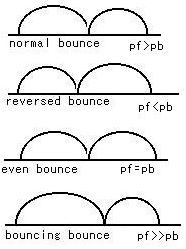| Concept |
| What is TP music? Aratori's style of TP music Lennie Tristano Bud Powell Computer music |
TP music concentrates TP among musical properties. While almost all music may have to some extent the property of TP but mainly as playing the role of enforcing other properties such as pitch or of individuating a performance of a player, TP music has it as playing significant role of constituting music. The style of TP music is the improvisational and atonal music played along four-beat base with constant tempo. Aratori's style of TP music has been developed, succeeding to Lennie Tristano's original solo piano style, but originates with Bud Powell in the aspect of method of body and mind, and of concept of fluctuation of timing; it is also derived from his experience of playing with Toshihisa Morita. Another style of TP music may be thinkable because of no reason for limiting it to solo keyboard. TP will be applied to computer music for which the devices to product timing fluctuation are needed. But TP music uses computer not for producting but for realtime recording and analizing itself. It is an expriment for understanding human's timing perception and becomes reliable experimental data after decades' excise. |
| Unnotated timing |
Unnotated timing Musical symbol is classified as notated symbol: parallels to usual musical notation written in score, notated pitch symbol: A, A#, B, C, etc., notated loudness symbol: accent, etc., notated timing symbol: eighth note, etc., unnotated symbol: can not be transcribed into score, unnotated pitch symbol: piano or vibraphone cannot use this, unnotated loudness symbol: expressed as 0-127 in MIDI data, unnotated timing symbol: expressed as 0-479 (0-239, 0-359 etc.) in MIDI data. I doubt that unnotated pitch symbol or unnotated loudness symbol can play main role in constituting some music. But unnotated timing symbol, I think, indeed plays. |
symbol |
| Subtle timing? Conflict Bud Powell |
Unnotated timing is similar to but different from subtle timing. The former involves the latter, but the latter does not the former. For unnotated timing means not only that duration or deviation is too small to notate (perceive notationally) but also that it is long enough to notate and left un-notated and so perceived unnotationally. Here is a conflict between notated and unnotated timing perception. A TP musician must make it a habit to manage to do that conflict. You can realize the basic way of it when listening to Bud Powell, who is the basis of timing fluctuation in jazz. |
| NOTE | 'Timing' of 'timing progression' means not notated timing but unnotated timing. So, 'timing progression' should be 'unnotated timing progression' and 'timing-progression.com' 'unnotated-timing-progression.com'. But they are too long to be the keywords and 'unnotated' is not a familiar term, so cut short. The abbreviation does not imply that unnotated timing involves notated timing. Moreover, unnotated timing which I refer to is a part of that, that is systematized by TP. |
| Proportion normal, reversed, even, bouncing (bounce) Main concept |
Most important property of unnotated timing is proportion of a pair of eighth notes that shows how they bounce. In usual cases, the proportion is long/short, i.e. length of 1st (front) eighth note is longer than that of 2nd (back) (*). Let us call it normal bounce. When, on the contrary, the proportion is reversed into short/long, let us call it reversed bounce. When it is almost even, even bounce, and when distinguishably long/short, bouncing bounce. TP musicians can articulate and constitute music through manipulating the proportion and other features of unnotated timing. This is main concept of TP. Thus, TP music needs successive eighth notes, but in slow tempo in turn other notes. (*) Length of note means here length from the note-on timing to the next note's note-on timing. The technical definition is shown in 'research' section. Incidentally, duration is defined in MIDI as length from note-on timing to note-off timing. |
Mathematical definition, to Research  proportion of a pair of eighth notes |
| Ratio? Beat length Extended beat |
You might mistake proportion for ratio. Proportion is not like '53:47 49:51 55:45 61:39' i.e. ratio of dividing a fixed-length (100) metronome beat, but like '50:44 47:49 55:45 66:44'. In the former 'unnatural' case, beat length 'pf+pb' is fixed as 100, but in the latter case, it is diverse: '94 96 100 110'. Extended beat is the beat whose beat length is substantially longer than around beats, like 110 above. It is also significant feature of unnotated timing. |
53+47=100 49+51=100 55+45=100 61+39=100 50+44=94 47+49=96 55+45=100 66+44=110 pf, pb, etc. cf. Proportion Figure 2 |
| The first hypothesis of TP | Bounce expresses properties of timing perception. The first hypothesis of TP is on 'What is bounce? Why do we need timing fluctuation?' Human perception of timing of musical tones has, as any other perception does, a property that the perception itself needs time, which varies (several tens milliseconds) depending not only upon 'situations and ways of perception' but also upon 'each tone's location' in timing structure. 'Situations and ways of perception' involve for example not only natural circumstances like climete, moon cycle and equinox but also our emotions and feelings and imeges, whose positive participation to perception calls the phirosophical problem of self-reference of perception. 'Each tone's location' involves for example not only a front eighth note or a back eighth note, etc. but also each tone's characteristic in the seqense. TP expresses properties of the perception through timing fluctuation. That is the bounce". NOTE: This is the first hypothesis of TP which may asociate all sorts of approaches to TP from numerical research to practical methods. Listening to and playing and researching TP music may enable us to classify our varied properties of the perception. |
